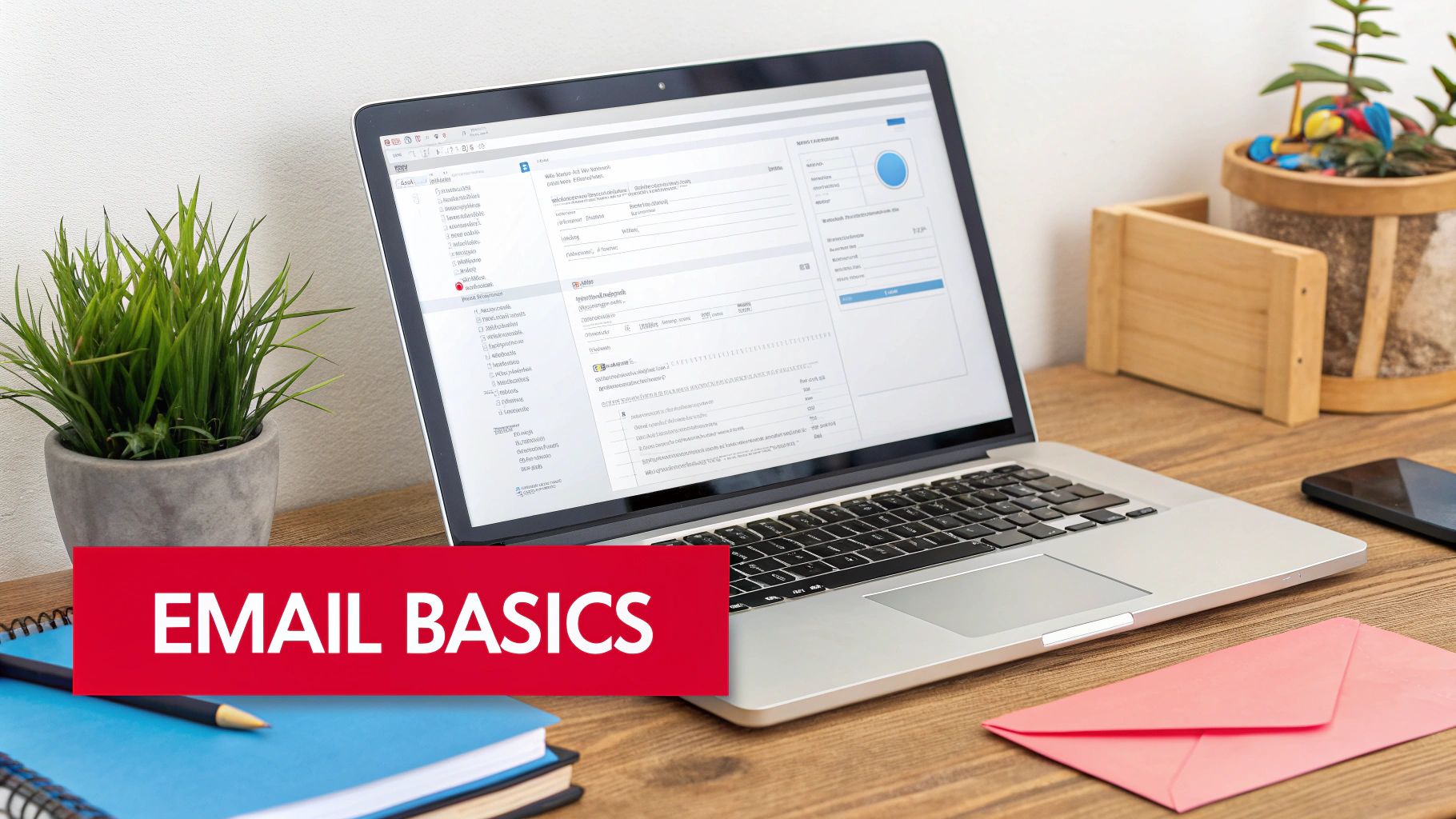
Mastering Email Marketing Fundamentals

Let's explore the core principles of email marketing for beginners. This guide focuses on practical knowledge, empowering you to build effective email campaigns. We'll examine the key metrics that drive success and demonstrate how small changes can significantly improve your results.
Understanding Key Email Marketing Metrics
Before sending your first campaign, it's essential to understand your objectives. Key metrics offer a way to measure success and pinpoint areas for improvement. These metrics include your open rate, which is the percentage of recipients who open your email. They also include your click-through rate (CTR), the percentage who click a link within the email. Finally, your conversion rate represents the percentage who complete a desired action, such as making a purchase.
For instance, a high open rate suggests an effective subject line. A low CTR, however, could indicate a mismatch between your email content and your call to action.
Keeping an eye on your unsubscribe rate is also important. A high unsubscribe rate may signal problems with your content's relevance or how often you send emails. Interestingly, email marketing generally has very low unsubscribe rates.
This means subscribers tend to stay engaged with your brand. This speaks to the enduring power of email as a marketing channel.
Email marketing is effective because it allows for targeted and personalized messaging. Canadian consumers value communication that is both relevant and respectful. This personalized approach builds stronger customer relationships and drives better results than generic, mass emails.
This focus on personalization is evident in Canadian email marketing statistics. Approximately 83% of Canadian businesses use email marketing as part of their overall strategies. With about 29 million people (85% of the population) regularly using email in Canada, it's a highly effective channel for marketers. Learn more at Canadian email marketing statistics.
Crafting Your First Email Marketing Strategy
A successful email marketing strategy involves several key steps. First, define your target audience. Consider who you're trying to reach and what their interests and needs are. This understanding shapes your content and messaging.
Next, build a high-quality email list. Prioritize quality over quantity. Attract subscribers who are genuinely interested in your brand by offering valuable lead magnets, such as exclusive content or discounts.
Then, select the right email marketing platform, like Mailchimp or Constant Contact. Choose one that aligns with your budget and provides the features you need, such as automation and analytics. This will streamline your workflow and help you track your progress.
Finally, create compelling emails. Focus on clear, concise messaging, engaging visuals, and strong calls to action. A/B testing different email elements, like subject lines and calls to action, helps optimize your results. A well-crafted email can significantly impact your conversion rates.
Building a Responsive Email List That Actually Engages

Forget vanity metrics like a massive email list that never opens your emails. This section focuses on building a responsive email list for beginners, one that truly engages with your content. We'll explore effective tactics that prioritize quality subscribers over inflated numbers.
Crafting Irresistible Opt-In Offers
Attracting engaged subscribers starts with offering something they truly value. Think of it as a valuable exchange: their email address in return for a helpful resource. This resource is your opt-in offer or lead magnet.
- Ebooks or Guides: Share specific knowledge related to your niche.
- Checklists or Worksheets: Offer practical tools for solving particular problems.
- Exclusive Discounts or Promotions: Give subscribers a special incentive to subscribe.
- Free Webinars or Online Events: Deliver important information and build connections.
These offers should be valuable and easily accessible. Prioritize quick wins and immediate value for your subscribers.
Designing Friction-Free Signup Experiences
A compelling offer needs an easy signup process. Any friction can significantly impact your conversions.
- Minimize Form Fields: Request only essential information; usually, an email address is sufficient.
- Optimize for Mobile: Ensure your signup forms are mobile-friendly for smartphones and tablets.
- Use Clear Call-to-Actions: Make subscribing clear and straightforward. Use action-oriented language like "Download Your Guide Now" or "Become a Member Today."
A simple signup process efficiently converts visitors into subscribers. For further guidance on optimizing your forms, you might find this resource helpful: How to master form design on webfluence.store.
Leveraging Existing Touchpoints and Avoiding Pitfalls
Organic list growth involves using your current platforms. Promote your opt-in offer on your website, social media channels, and even in your physical store, if applicable.
Avoid the pitfall of buying email lists. While tempting, purchased lists often result in low engagement and high spam complaints, hindering your email marketing efforts.
Ensure you comply with CASL (Canadian Anti-Spam Legislation). A double opt-in, requiring subscribers to confirm their subscription, is essential for CASL compliance. This confirms consent and builds a list of truly interested subscribers.
Canadian email engagement provides valuable context. Between 2013-2018, average unique open rates ranged from 16.1% to 18.1%, and click-through rates averaged 2.5%, recently increasing to 4%. Truehost provides further statistics to benchmark your performance and set realistic expectations.
To help you choose the best tactic for your business, the following table outlines the effectiveness, difficulty, and cost considerations of various email list building strategies:
Email List Growth Tactics: Effectiveness Comparison This table compares different email list building strategies based on their effectiveness, implementation difficulty, and cost for beginners.
| List Building Tactic | Average Growth Rate | Implementation Difficulty | Cost | CASL Compliance Considerations |
|---|---|---|---|---|
| Content Upgrades (e.g., checklists within blog posts) | High | Medium | Low | Ensure clear consent and double opt-in |
| Pop-up Forms | Medium | Low | Low | Ensure forms are not intrusive and double opt-in is implemented |
| Landing Pages for Specific Offers | High | Medium | Low to Medium | Double opt-in is essential |
| Social Media Contests | Medium | Medium | Low to Medium | Clearly outline contest rules and CASL compliance |
| Running Ads (e.g., Facebook, Google) | Medium to High | Medium to High | Medium to High | Ensure targeted audience and compliance with advertising platform policies, integrate double opt-in |
This table provides a starting point for evaluating different list-building tactics. Remember that the best approach depends on your specific audience and business goals.
Building a High-Quality Email List
Building a responsive email list is fundamental to successful email marketing. By prioritizing genuine engagement, offering valuable resources, and streamlining the user experience, you can cultivate a loyal audience receptive to your messages. This sets the stage for long-term success, fostering connections with subscribers and achieving your marketing objectives.
Selecting Your Perfect Email Platform (Without Overpaying)

Finding the right email platform for beginners in email marketing shouldn't drain your budget or demand advanced technical know-how. This section guides you through the available choices, helping you select the best fit for your needs as you start your email marketing journey in Canada. We'll concentrate on the features that genuinely matter for beginners, helping you avoid unnecessary costs.
Essential Features for Beginners
As a beginner, focus on these key features when evaluating email marketing platforms:
- Ease of Use: Look for a platform with a user-friendly interface, including drag-and-drop editors and straightforward navigation to simplify creating your email campaigns.
- Email Templates: Pre-designed templates are a lifesaver, saving you time and ensuring a professional appearance, even without design experience.
- Automation Capabilities: Basic automation features like welcome emails and autoresponders can streamline your communications and save you valuable time.
- List Management: Essential features such as segmentation and tagging will help you organize your subscribers and send more targeted messages.
- Reporting and Analytics: Track essential metrics like open rates and click-throughs to understand how your campaigns are performing.
- CASL Compliance Tools: For Canadian businesses, features like double opt-in and consent management are crucial for staying compliant with Canadian anti-spam legislation.
These core features provide the essential building blocks for any effective email marketing strategy, giving you the tools to cultivate and grow your audience.
Comparing Popular Email Platforms
To help you compare, we've created a table summarizing some popular email platforms and their suitability for beginners in Canada:
To help you choose the right email marketing platform, we've compiled a comparison table highlighting key features and pricing relevant to beginners in the Canadian market.
| Platform | Free Plan Limits | Beginner-Friendly Rating | Key Features | Starting Price | Canadian Compliance Tools |
|---|---|---|---|---|---|
| Mailchimp | 500 contacts, 1,000 sends/month | Excellent | Automation, templates, landing pages | Free, Paid plans from $15/month | Double opt-in, consent management |
| Constant Contact | 500 contacts | Very Good | User-friendly interface, robust reporting | $19/month | Double opt-in, list-building tools |
| Brevo (formerly Sendinblue) | 300 emails/day | Good | Transactional emails, automation workflows | Free, Paid plans from $27/month | Double opt-in, GDPR compliant (helps with CASL principles) |
| AWeber | 500 subscribers | Good | Automation, segmentation, landing pages | $16.15/month | Double opt-in, subscriber management |
| GetResponse | No free plan | Fair | Advanced automation, landing pages, webinars | $22/month | Consent fields, automation workflows |
This table offers a quick overview of each platform's pricing and essential features. Remember to visit the platform websites directly for the most up-to-date details, as pricing and features can change.
Scaling Considerations
A free plan might be sufficient when you’re starting out, but it’s essential to consider your future needs. As your subscriber list grows, anticipate increasing costs and the need for more advanced features. Some platforms are better suited for scaling than others. Also, check out the learning resources offered by each platform. Many provide helpful materials and support documentation specifically designed for beginners, so you can effectively use your chosen platform as your email marketing program expands.
Crafting Emails People Actually Open and Read

Creating emails that truly connect with Canadian audiences requires more than just selecting a pre-designed template. It involves understanding the psychology of what motivates people to open, read, and ultimately, act. This section explores the crucial components of effective email creation for those new to email marketing.
The Power of the Subject Line and Preheader
Your subject line is your first, and often only, chance to make an impression. It acts as the gateway to your email's content. A captivating subject line sparks curiosity and entices recipients to open the email. Think of it as a compelling headline that must grab attention amidst the clutter of a busy inbox.
Instead of a generic subject line like "New Product Announcement," consider something more targeted and engaging, such as "Introducing the New [Product Name]: Designed for You." The preheader, the brief text snippet following the subject line, further reinforces your message and provides additional context to encourage opens. The combination of a strong subject line and preheader is key to capturing a reader's attention.
Structuring Your Email for Engagement
Once your subject line and preheader have piqued interest, the structure of your email body becomes paramount. Keep paragraphs concise, focusing on a single key idea per paragraph. Use headings and bullet points to break up the text, making it easier to skim and digest.
Considering that over 60% of Canadians access their emails on mobile devices, optimizing for mobile viewing is essential. This includes using clear, readable fonts and implementing a responsive design that adapts to different screen sizes.
Different Emails for Different Purposes
It's important to recognize that not all emails serve the same function. Promotional emails, such as sales announcements, aim to drive immediate action. Transactional emails, like order confirmations, deliver essential information. Relationship-building emails, such as newsletters, cultivate long-term engagement.
Understanding these differences helps tailor your content and tone accordingly. A promotional email might employ a sense of urgency, while a relationship-building email might prioritize providing value and fostering connection. Choosing the right email type for your objective is essential for effectively reaching your audience.
Calls to Action and Personalization
A clear and compelling call to action (CTA) is vital for converting readers into customers. Your CTA should explicitly state the desired action and make it easy for readers to take that action. Employ action-oriented language, such as "Shop Now," "Learn More," or "Book a Consultation."
Personalization extends beyond simply including the recipient's name. Utilize data to tailor content to individual interests and past behavior. This creates a more relevant and engaging experience for the reader. You might find this resource helpful: How to master....
The email advertising market in Canada is projected to reach US$322.13 million in ad spend, growing at a 1.56% CAGR. This substantial investment reflects the channel's robust ROI, with Canadian businesses seeing a return of about $36 for every dollar spent on email marketing. More detailed statistics can be found here. This underscores the enduring importance of email marketing in the Canadian business landscape. By creating emails that are genuinely engaging and relevant, businesses can harness this powerful channel to achieve their marketing goals.
Email Automation That Works While You Sleep
Tired of manually sending emails one by one? Imagine building automated systems that nurture your leads while you rest. This section demystifies email automation for beginners, providing practical frameworks specifically for Canadian businesses. We'll explore how automated email sequences can enhance engagement, even without advanced technical skills, using real-world examples from successful marketers.
Creating a Welcome Sequence That Converts
First impressions are everything. A welcome sequence is a series of automated emails triggered when someone joins your email list. This is your opportunity to introduce your brand, set expectations, and deliver immediate value. It's akin to a warm welcome at a networking event, helping to establish rapport and guiding subscribers towards valuable content.
- Email 1: Thank You and Welcome: Express gratitude for their subscription and reiterate the benefits they'll receive.
- Email 2: Brand Story and Values: Share your brand's mission and connect with subscribers on a more personal level.
- Email 3: Key Resources or Offers: Provide helpful content or exclusive discounts to promote further interaction.
This consistent initial contact maximizes the impact of your first interaction with new subscribers.
Recovering Lost Sales with Abandoned Cart Reminders
Abandoned cart emails are invaluable for e-commerce businesses. These automated messages are sent when a customer adds items to their cart but leaves without completing the purchase. Think of them as a gentle reminder, showcasing the chosen items and often offering an extra incentive, like free shipping or a discount, to encourage the sale. They are remarkably effective at recovering lost revenue and improving conversion rates.
For instance, a simple reminder like, "Did you forget something? Your items are waiting! Enjoy free shipping for the next 24 hours," can re-engage customers and encourage them to complete their purchase.
Winning Back Inactive Subscribers Through Re-engagement Campaigns
Subscriber activity can wane over time. Re-engagement campaigns aim to revive interest among those who have become less active. These campaigns typically offer a special promotion, a valuable piece of content, or simply request feedback to enhance communication. It's a chance to reconnect with valuable subscribers and gain insights into their disengagement.
The Power of Segmentation in Email Automation
Segmentation empowers you to deliver more targeted and relevant messages. By dividing your audience into smaller groups based on shared interests, demographics, or past actions, you can personalize automated email sequences. This precision ensures your messages reach the right people at the opportune time, boosting their effectiveness.
For example, a clothing store might segment their list by gender and send customized product recommendations or promotions. This personalization leads to higher engagement and improved conversions.
Maintaining Authenticity in Automated Messaging
While automation improves efficiency, genuine communication remains crucial. Canadian consumers value personalized messages but also expect respectful, non-intrusive interactions. Prioritize building relationships by offering helpful content, addressing their needs, and respecting their communication preferences. You might find this resource helpful: How to master email segmentation and automation on webfluence.store.
By implementing these email automation strategies, you can establish efficient systems that cultivate leads, recapture lost sales, and re-engage inactive subscribers, all while respecting Canadian consumers' desire for personalized, respectful marketing. This smarter approach maximizes your email marketing impact.
Measuring What Actually Matters: Beyond Basic Metrics
Building a successful email marketing program for beginners means looking past vanity metrics and focusing on the data that truly drives action. It's not enough to know how many people opened your email; the real question is what they did afterwards. This section will equip you with the knowledge to transform complex metrics into usable insights, improving your email marketing in Canada.
Understanding Canadian Industry Benchmarks
Comparing your results to Canadian benchmarks offers valuable perspective. Understanding the average open and click-through rates for your specific industry within Canada allows you to set realistic objectives. For example, if the average open rate for similar businesses in Canada is 20%, and yours is 15%, you've identified a clear opportunity for improvement. On the other hand, exceeding the benchmark validates the strength of your current approach. This comparative analysis keeps your efforts aligned with market realities.
Setting Up Simple Tracking Systems
You don't need complex software to track important metrics. Most email marketing platforms designed for beginners include basic analytics dashboards. These tools track key data like open rates, click-through rates, and conversion rates. This information helps you assess the effectiveness of your subject lines, calls to action, and overall email content. Even a simple spreadsheet can help you monitor progress and spot trends over time. This readily available data empowers you to make informed adjustments to your campaigns.
Making Data-Informed Decisions
Once you have a grasp of the fundamentals, consider exploring practical strategies like automating your email campaigns. This can save time and boost engagement. For more information on this topic, check out this guide to email automation best practices. Data-driven decision-making should be the cornerstone of your email marketing strategy. For instance, if your data reveals a particular audience segment consistently engages with content about a specific product, you can personalize future emails for that segment, highlighting similar products or offers. This targeted approach makes your messaging more relevant and encourages conversions.
A/B Testing for Optimization
A/B testing, also known as split testing, involves sending two different versions of your email to separate segments of your email list to determine which performs better. This straightforward method can significantly improve your results. Experiment with different subject lines, email body copy, images, and even send times. By analyzing which version generates higher open or click-through rates, you can refine your email elements for more effective campaigns.
Establishing Realistic Expectations
It's essential to recognize that email marketing is an ongoing process of improvement, not a quick fix. Don't aim for an unattainable ideal. Instead, focus on incremental progress, setting achievable goals, and recognizing small victories. This consistent approach helps you build a sustainable email marketing program. Remember to consider your audience demographics and industry as well. A niche business might have lower open rates but higher conversion rates compared to a broader consumer brand.
Navigating Canadian Email Compliance With Confidence
Building a successful email marketing strategy in Canada, especially for beginners, requires a solid understanding of the Canadian Anti-Spam Legislation (CASL). This section breaks down CASL requirements into digestible guidelines, empowering you to develop a compliant email program.
Understanding CASL and Its Implications
CASL governs the sending of commercial electronic messages (CEMs). This includes emails, text messages, and instant messages sent to electronic addresses in Canada. The cornerstone of CASL is consent. You must obtain either express or implied consent before sending any CEMs. Express consent involves a recipient actively agreeing to receive your emails, usually via a checkbox or signup form. Implied consent applies under specific situations, such as a pre-existing business relationship.
Consent isn't a one-time event; it requires ongoing tracking and thorough documentation. Without proof of consent, you risk significant penalties. This highlights the importance of meticulous record-keeping within your email marketing practices.
Obtaining and Documenting Consent
A best practice for obtaining express consent is implementing a double opt-in process. This involves sending a confirmation email after signup, requiring the recipient to click a link to verify their subscription. This extra step safeguards against accidental signups and strengthens your proof of consent.
Maintaining accurate records of when and how consent was obtained is paramount. Your email marketing platform might offer built-in tools for managing this. Alternatively, a separate spreadsheet can be a useful tool. Detailed documentation is essential for protecting yourself in the event of a CASL investigation.
Compliant Unsubscribe Mechanisms
Providing an easy unsubscribe process is a non-negotiable aspect of CASL compliance. Emails must include a clear and readily apparent unsubscribe mechanism, typically a link at the bottom. This link must function immediately, without requiring additional steps like logging into an account. This empowers subscribers to easily manage their communication preferences with your brand.
CASL-Compliant Email Templates
Your email templates themselves must adhere to CASL guidelines. They should clearly identify your business, include your contact information, and explicitly state the purpose of the communication. Transparency is key for building trust and maintaining clear communication with subscribers. This open communication fosters stronger relationships with your audience.
Conducting Regular Compliance Audits
Regularly auditing your email marketing practices ensures ongoing CASL compliance. This involves checking signup forms, confirmation emails, and unsubscribe processes. Promptly identifying and addressing any gaps minimizes potential risks.
By understanding and implementing these guidelines, you can cultivate trust with your subscribers and confidently navigate the Canadian email marketing landscape.
Want to build, grow and dominate your market with a responsive email list? Visit WebFluence to learn more and start creating impactful email campaigns today.










